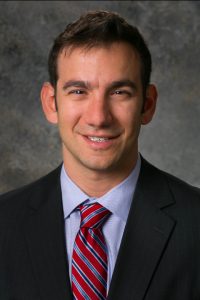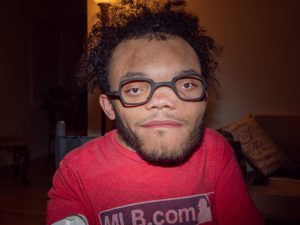Meet Dr. Frank Brodie. His accomplishments are many and quite impressive. You may already know him as one of the Loving Eyes Foundation (LEF) Co-Founders. Presently, Dr. Brodie is a first-year vitreoretinal fellow at Duke University Eye Center, in Durham, NC. He will readily tell you he hadn’t planned to be a doctor. After completing his undergraduate degree in political philosophy, he moved to Minnesota to work at General Mills corporate headquarters on their successful Fruit Roll-ups portfolio, working on the innovation team developing new types of snacks for children. However, coming from a family of physicians (including two retinal specialists!) genetics won out and he did a post baccalaureate and pursued a career in medicine.
Dr. Brodie received his medical degree from the Perelman School of Medicine at University of Pennsylvania and MBA from the Wharton School. He then moved to San Francisco for his residency at UCSF. While there he rotated through the children’s hospital and as a residency research project developed a novel approach to producing custom glasses for children with craniofacial malformation – this would later become the non-profit organization, The Loving Eyes Foundation. During residency Dr. Brodie had found a passion for translational research and medical device innovation (thoughout his residency he collaborated with scientists at the California Institute of Technology to develop novel ophthalmic devices). He became the third fellow at Stanford Byers Eye Institute Ophthalmic Innovation Program in Palo Alto, CA. This unique, immersive one-year program combined mentorship, resources and experiences with Stanford BioDesign and the Food and Drug Administration (FDA).
RetinaLink met with Dr. Brodie to find out what’s next for the Loving Eyes Foundation, his experience at Stanford’s Ophthalmic Innovation program and challenges as a first-year retina fellow.
RetinaLink (RL): You are one of Loving Eyes Foundation Co-Founders. Please explain the genesis and why LEF is important to you.
Frank L. Brodie, MD, MBA (FLB): While doing my residency at the University of California in San Francisco, I started working with UCSF Chief of Pediatric Ophthalmology, Dr. Alejandra de Alba Campomanes. Several of our pediatric patients had congenital craniofacial abnormalities. I was surprised to discover just how common the problem is – 1 out of 500 births have some degree of craniofacial malformation. We had patients losing vision to amblyopia just because they couldn’t find glasses that fit. I was hearing more and more about 3D printing and thought we could use it to make custom glasses for the children. Together with Dr. de Alba and Andy Corley, we started the Loving Eyes Foundation to provide custom glasses to these children. Originally we used old CT’s and MRI’s to map out the child’s unique anatomy, but have recently transitioned to using the FaceID camera on the iPhone which provides high resolution imaging in real time.
RL: What craniofacial conditions has the Loving Eyes Foundation treated?
FLB: Conditions we have treated include Microtia (Unilateral and Bilateral), Flat/Absent Nasal Bridges, Osteosarcomas, Crouzon Syndrome, Apert Syndrome and other mixed craniosynostoses.
We recently fit a young man who although he did not have a large refractive error it was enough to keep him from driving, and in turn prevent him from attending college in a nearby town. We were able to develop a pair of glasses that fit him and he’s enjoying his freshman year.
“We would love to say a big “Thank You” to you and the whole team. It’s so difficult for individuals, like our son, to find eyeglasses, it’s even more difficult to find a program like yours to create custom fitting eyeglasses for people suffering from rare bone conditions. If it weren’t for your generosity, we wouldn’t have had any hope as our options had dried up and we didn’t know where to turn. It has been very difficult for him to function with basic daily activities with his impaired vision. What your team has done for us is invaluable. We can’t thank you enough for all the hard work and time you and your team put into fitting our son with glasses,” A LEF’s Patient’s Mother said.
RL: What are LEF’s biggest challenges now and what’s the future plan?
FLB: The transition to iPhone based scanning has been a huge advance. It has made recruitment and design much easier. Previously our lead time was several months. Now we can get out a first pair of glasses in weeks. We still struggle with fine tuning the fit and usually go through 2 to 3 iterations. However, we are learning from each pair and getting better. In the future Artificial Intelligence (AI) will be another pivotal technology to incorporate in the project. We hope to use AI to automate facial landmark identification and measurement with the hope of automating design (which is still very much manual). We’ve been fortunate to have wonderful partnerships including Standard Cyborg who developed the scanning software, Essilor who donates all the lenses, Carbon and Resolution Medical who do our 3D printing and especially the Allergan foundation who has provided generous support for LEF.
RL: Outline your work during Stanford’s Ophthalmic Innovation program.
FLB: I was Stanford’s Ophthalmic Innovation Fellow 2018–19. I had the opportunity to collaborate with Drs. Mark S. Blumenkranz, Dave Myung and Daniel Palanker. It’s hard to overstate the impact that this group has had on ophthalmology and retina in particular; ranging from the PASCAL laser to gene therapy and the Pixium artificial retina. Additionally I was able to work with the Stanford BioDesign program, a well-known group which has churned out high impact devices across all specialities. Finally, Drs. Blumenkranz and Myung developed an program with the ophthalmic group at the FDA in which the innovation fellow spends several weeks on site at the FDA learning about the regulatory process and getting the opportunity to organize a national workshop on a current regulatory topic. This past spring I was able to help organize the FDA sponsored “Forum on Laser Based Imaging” in which leaders from practice, academia, industry and regulators gathered to discuss the most pressing issues in this rapidly evolving field. It was a whirlwind of a year but an unbelievable opportunity to learn and work with so many giants in the field.
Dr. Mark S. Blumenkranz, Stanford University, Byers Eye Institute, HJ Smead Professor Emeritus, said, “Frank was an exceptionally talented collegial and productive ophthalmic innovation fellow at Stanford. He was a pleasure to work with and in addition to outstanding work in regulatory science made significant contributions in advancing new technology for IOL implantation in eyes with a history of trauma and customized fitting of spectacle correction for children with cranial-facial dysmorphic abnormalities. I fully expect him to be one of the leaders of a new generation of ophthalmic innovators.“
RL: You started your vitreoretinal fellowship in July 2019. What is your advice for incoming first year vitreoretinal fellows?
FLB: Rest up. You will be busy each and every day. Recognize you have a unique opportunity with incredible depth and breadth of resources. Take advantage of journal clubs, outside opportunities and collaborating on research with your attendings. Get to know the Faculty. Their experiences and contributions have shaped our current practice patterns and they have trained many generations of fellows. Don’t be embarrassed to ask the dumb questions or let them know when you find something challenging. They are there to teach and know how to do it well.
I’ve been fortunate to have found terrific mentors and colleagues at Duke and am enjoying the mix of surgery, clinic and research. Being part of the larger university setting is a huge asset as I’ve been able to collaborate outside of the Department of Ophthalmology not only with other medical departments but also with the School of Engineering.
RL: You have a limited amount of downtime based on your training and LEF commitments. When you have some downtime, what do you enjoy doing?
FLB: I spend my time with my family. My wife is an OB/GYN at Duke and we have a 1-year-old son and 3-year-old golden retriever (who thinks he is a lap dog despite weighing 95 pounds). We’re all enjoying exploring Durham including the great hiking trails and delicious southern BBQ. And, of course Duke Basketball when I can wrangle a ticket!
Dr. Frank Brodie can be reached via e-mail – frank.brodie@duke.edu
You can learn more about The Loving Eyes Foundation at http://www.lovingeyesfoundation.org


